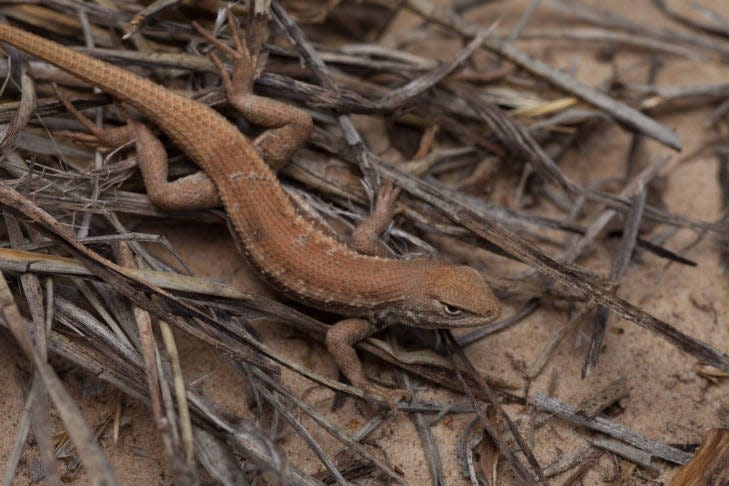Dunes sagebrush lizard's federal protections delayed amid opposition from oil and gas
Protections for a struggling lizard amid southeast New Mexico’s oilfields were delayed by about a month in response to fossil fuel industry concerns as the federal government collects public input on the proposal.
That could result in a listing of the dunes sagebrush lizard as either endangered or threatened under the Endangered Species Act, meaning lands in New Mexico and West Texas could be blocked from development as the species is recovered.
The lizard was proposed for a listing by the U.S. Fish and Wildlife Service in June, opening a 60-day public comment period to solicit impact until Sept. 1.
More: Feds want more evidence from ranchers who blame lobos for livestock killings in New Mexico
But on Aug. 29, the Service announced it extended public comments to Oct. 2, opting for a 90-day period, with a final decision expected after that.
The agency was petitioned in 2018 for the listing, finding such an action could be warranted in 2020, and publishing its proposal June 29.
It faced opposition from oil and gas groups and industry supporters for the impacts the listing could pose to extraction operations and associated activities like sand mining in the area.
More: Pinyon jay native to New Mexico's piñon forests could be protected from extinction
The lizard’s habitat spans southeast New Mexico and West Texas, an area within the Permian Basin oil and gas field, the U.S.’ biggest fossil fuel region producing up to 5.8 million barrels of oil per day and stimulating the economies of both states.

Comments submitted Aug. 25 by the Energy Workforce and Technology Council, which said it represents 250 companies and 600,000 workers in the energy sector, noted the broad impacts of the potential listing necessitating more time.
President Tim Tarpley said listing the lizard could increase costs for energy companies, impede planning and delaying projects by limiting allowable operations in the certain areas.
More: Checkerspot butterfly recovery could mean setting aside lands in Lincoln National Forest
He said the industry already engaged in voluntary conservation practices to help conserve species like the sagebrush lizard, doubting if additional federal action was needed.
Tarpley pointed to about 1.9 million acres in New Mexico enrolled in such agreements known as candidate conservation agreements that see landowners undertake certain practices to preclude them from future restrictions should a listing be enacted.
He argued the comment period should be extended to allow the industry to respond.
More: Dunes sagebrush lizard proposed as endangered species amid threats from oil and gas
“While the Sagebrush Lizard favors the welcoming landscape of Texas and New Mexico, this same habitat plays home to our nation’s most critical oil and gas developments,” Tarpley wrote. “Under these agreements, the industry has voluntarily committed to implementing practices that reduce or even remove the threat to the lizard.
“Placement of the Dunes Sagebrush Lizard on the endangered species list will further reduce production and development opportunities across our robust energy industry jobs in the region and infringe on private property rights.”
Similar concerns were expressed by the Western Energy Alliance in its comments submitted Aug. 4, calling for an extension due to drastic impacts President Kathleen Sgamma said the listing would have on energy production.
More: Congress votes to cut protections for lesser prairie chicken nearly extinct in New Mexico
“The Proposed Rule stands to have a significant impact on Alliance members' business planning and operations by increasing operational costs, delaying project timeframes, and limiting or precluding operations in certain areas,” Sgamma wrote.
The concerns did not come from the oil and gas industry alone, as the New Mexico Cattlegrowers Association contended in Sept. 1 comments the proposed listing could also impede agriculture in the region, arguing the lizard should not be listed at all.
President Loren Patterson cited voluntary work by his industry in mitigating its effects on wildlife.
More: Rare Pecos River fish included in federal settlement. Protections could come next year
“Given the extensive work that has been done to protect the species in this state and the effectiveness those actions have had, it would be improper to list the dunes sagebrush lizard as threatened or endangered in New Mexico,” Patterson wrote. “The New Mexico Cattle Growers’ Association opposes the listing.”
Conservation groups disagreed, arguing the species continued to dwindle despite current efforts and past government action.
In response to the proposed listing, Michael Robinson at the Center for Biological Diversity blamed the federal government for allowing industry interests to slow the protection process thus far for the lizard.
“The Service needs to move quickly to implement these long-overdue protections," he said.
Adrian Hedden can be reached at 575-628-5516, achedden@currentargus.com or @AdrianHedden on Twitter.
This article originally appeared on Carlsbad Current-Argus: Dunes sagebrush lizard's federal protections delayed by a month

